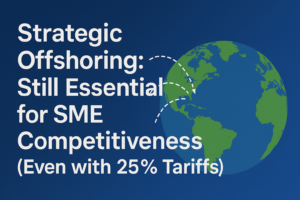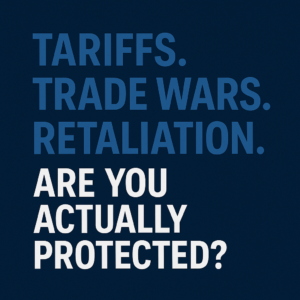
Executive Summary
The North American HVAC industry faces intense cost pressures, labor constraints, and evolving supply chain challenges. Mid-sized HVAC developers—companies generating between $50 million and $250 million in annual revenue—must carefully evaluate their manufacturing strategies to remain competitive.
This white paper examines the top five North American contract manufacturers suitable for commercial HVAC developers and provides a structured comparison of their strengths and weaknesses.
Beyond domestic contract manufacturing, we analyze a strategic alternative: leveraging a Design for Manufacturing (DFM) specialty engineering company to refine product designs and transition to fully managed offshore production in non-tariff countries such as India and Vietnam. By optimizing product design, material selection, and supply chain efficiency, HVAC companies can achieve significant reductions in Cost of Goods Sold (COGS), enhance quality, and reduce warranty liabilities.
I. Top Five North American HVAC Contract Manufacturing Companies
1. AAON, Inc.
Summary: Tulsa-based AAON is known for highly engineered, customizable HVAC solutions. Its innovative approach enables flexibility in product design.
Strengths:
- Expertise in customized HVAC solutions.
- High investment in R&D for energy-efficient designs.
- Strong North American distribution network.
Weaknesses:
- Premium pricing model.
- Limited scalability compared to larger multinational firms.
- U.S.-based manufacturing constraints.
2. SPX Corporation
Summary: A diversified industrial conglomerate with HVAC solutions, including cooling towers and heat exchangers.
Strengths:
- Extensive product range.
- Global presence with service and distribution networks.
- Reputation for durable, high-performance equipment.
Weaknesses:
- Complex corporate structure slows decision-making.
- Higher overhead costs.
- Premium pricing compared to offshore alternatives.
3. Johnson Controls International
Summary: A multinational provider of HVAC systems and building automation solutions.
Strengths:
- End-to-end HVAC solutions including smart controls.
- Strong global footprint with a vast service network.
- Advanced energy efficiency technologies.
Weaknesses:
- Higher operating costs.
- Less flexibility for product customization.
- Slower agility compared to niche-focused manufacturers.
4. KMC Controls
Summary: A U.S.-based specialist in HVAC control systems and building automation.
Strengths:
- Advanced building automation technology.
- Strong engineering and customer support.
- Customization capabilities.
Weaknesses:
- Narrow product focus; requires additional suppliers for full HVAC systems.
- Limited global manufacturing reach.
- Potential scalability constraints.
5. Nortek Global HVAC
Summary: A leading manufacturer of unitary HVAC products for residential and commercial markets.
Strengths:
- Diverse HVAC product portfolio.
- Scalable manufacturing capabilities.
- Established North American market presence.
Weaknesses:
- Higher labor and operational costs.
- Limited global cost efficiencies.
- Less aggressive in offshore production expansion.
II. The Strategic Case for Offshore Manufacturing
Mid-sized HVAC manufacturers seeking to reduce costs and improve efficiency must consider transitioning subassemblies and key components offshore. By partnering with a Design for Manufacturing (DFM) specialty engineering company, HVAC firms can optimize:
- Manufacturing Efficiency: Reducing complexity in designs to lower production costs.
- Material Science Optimization: Selecting alternative materials that enhance performance while reducing costs.
- Logistics & Inspection Efficiency: Streamlining supply chain and quality control to ensure seamless integration into final assembly.
Comparative Cost Analysis: North America vs. India/Vietnam
| Factor | North America (USA) | India | Vietnam |
|---|---|---|---|
| Average HVAC Labor Cost (per hour) | $25–$40 | $5–$8 | $4–$7 |
| Overhead Costs | High | Moderate | Low |
| Access to Industry 4.0 Tech | Medium | High | High |
| Manufacturing Quality Control | Good | Excellent | Excellent |
| Supply Chain Efficiency | High | Moderate | High |
| Cost-Reduction Potential | Low | High | High |
Key Financial & Quality Benefits of Offshore Production
- Labor Cost Reduction: Manufacturing in India and Vietnam dramatically reduces labor costs by over 70% compared to North America, without compromising quality when working with Industry 4.0-equipped factories.
- Quality Control Advancements: Contrary to misconceptions, modern offshore factories in India and Vietnam employ ISO 9001, AS9100, and Lean Six Sigma methodologies to ensure superior quality and reliability.
- Material Sourcing and Cost Optimization: With expert DFM consulting, offshore partners can recommend cost-efficient, high-performance materials that enhance durability while reducing raw material costs.
III. Why Offshore? Making the Business Case
- Cost Savings: Offshore manufacturing can lead to a 30–50% reduction in total COGS when executed with a strong DFM strategy.
- Scalability: India and Vietnam offer scalable production capacity, essential for HVAC manufacturers experiencing growth.
- Regulatory & Tariff Benefits: Non-tariff countries like India and Vietnam avoid punitive duties on imported HVAC subassemblies, reducing overall landed costs.
IV. Selecting the Right SKUs to Offshore
When evaluating which HVAC components to offshore, mid-sized manufacturers should prioritize high-volume, low-complexity subassemblies, including:
- Coils and Heat Exchangers
- Sheet Metal Components
- Blower Assemblies
- Electrical Control Panels
- Piping and Tubing Assemblies
V. Conclusion & Next Steps
For HVAC manufacturers, the shift to fully managed offshore production, preceded by strategic DFM optimization, presents a significant competitive advantage. Companies seeking to reduce COGS, improve quality, and scale efficiently should prioritize offshore engagement, leveraging expertise from trusted partners.
By embracing a data-driven approach, mid-sized HVAC developers can successfully transition to cost-effective and high-quality offshore manufacturing solutions that outperform domestic alternatives.
Bibliography & References
- U.S. Bureau of Labor Statistics, Manufacturing Wages Data (https://www.bls.gov)
- McKinsey & Co., The Future of HVAC Manufacturing (https://www.mckinsey.com)
- Harvard Business Review, Global Supply Chain Trends (https://hbr.org)
- Indian Ministry of Commerce, Manufacturing Cost Reports (https://commerce.gov.in)
- Vietnam Ministry of Industry, Industrial Manufacturing Reports (https://www.moit.gov.vn)
#HVAC #Manufacturing #Outsourcing #SupplyChain #IndiaManufacturing #VietnamManufacturing #COGSReduction #HVACIndustry #Industry40 #LeanManufacturing #DFM #Engineering #OffshoreManufacturing #HVACTech #B2BManufacturing
Youtube
Instagram
Linkedin
Facebook-f
#QualityControl #VietnamManufacturing #Manufacturing2024 #OffshoreManufacturing #REDUxEngineering #QualityAssurance #ManufacturingTips #TechInManufacturing #AuditProcess #InspectionProcess






